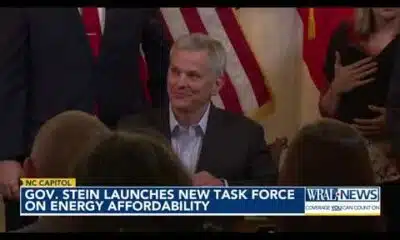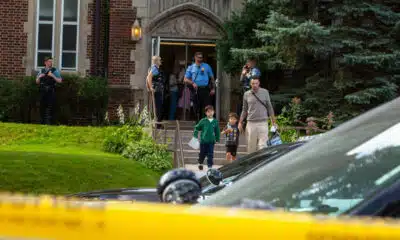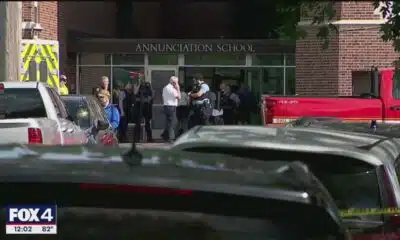News from the South - Texas News Feed
Under Trump, Texas reins in border spending to $3.4 billion
“Amid Trump immigration crackdown, Texas reins in border spending and shifts focus to deportations” was first published by The Texas Tribune, a nonprofit, nonpartisan media organization that informs Texans — and engages with them — about public policy, politics, government and statewide issues.
Sign up for The Brief, The Texas Tribune’s daily newsletter that keeps readers up to speed on the most essential Texas news.
For four years, Texas’ Republican leaders argued President Joe Biden’s immigration policies were so lax that they had no choice but to spend an unprecedented $11 billion in state money to secure the border.
Now with President Donald Trump in office, illegal border crossings have sunk to historic lows — and the state is continuing to spend another $3.4 billion on border security over the next two years, more than four times what lawmakers ever budgeted before the Biden-era buildup.
The way the money will be used reflects Texas’ changing strategy in reaction to Trump’s return to the White House, propelled by campaign promises to deliver mass deportations of undocumented immigrants.
Most of the $3.4 billion will go to the Texas Department of Public Safety and Texas Military Department, the agencies that have enforced the state’s four-year crackdown by surging police and National Guard troops to the border. Paired with newly approved legislation that will require local cooperation with federal immigration authorities, those agencies will be positioned to offer the Trump administration extra manpower for its immigration enforcement efforts across the state, including raids hundreds of miles from the border.
In their final state budget draft, lawmakers also slashed funding for Texas’ incomplete border wall, a further display of the state ceding border traffic control to the feds and focusing its own resources on interior enforcement.
[With only 8% built, Texas quietly defunds state border wall program]
Both DPS and the Guard have already emerged as force multipliers for the Trump administration’s enforcement apparatus. During Trump’s first weeks in office, Gov. Greg Abbott directed DPS to work with U.S. Immigration and Customs Enforcement and signed an agreement with ICE to let the Guard make immigration arrests.
“Thanks to President Trump’s bold leadership, the federal government is finally fulfilling its obligation to secure the southern border and deport criminal illegal immigrants. Because of these renewed federal assets in Texas, our state can now adjust aspects of state-funded border security efforts,” Abbott press secretary Andrew Mahaleris said in a statement. “Texas will continue to maintain a robust presence with our federal partners to arrest, jail, and deport illegal immigrants.”
Mahaleris added that specialized units within DPS and TMD will “carry on their missions both at the border and throughout Texas.”
Already, DPS has developed regional strike teams at the governor’s direction across the state to support federal authorities, including ICE, DPS spokesperson Sheridan Nolen previously told The Texas Tribune. As of early April, the agency had identified nearly 5,800 “criminal illegal immigrants with active warrants,” she said.
“DPS’ tactical strike teams are a part of the department’s continued focus on preventing, detecting and interdicting criminal activity — including the arrest of criminal illegal immigrants in Texas,” Nolen said, adding that the units — working with Trump’s newly formed Homeland Security Task Forces — were focused on arresting “people who have entered the United States illegally and then gone on to commit crimes in the state.”
The border was already quiet when Trump returned to office after Biden last summer widely restricted asylum. But it has grown even quieter.
In May, Border Patrol agents arrested 12,452 people for illegally crossing the southwest border, according to the most recent figures from the Department of Homeland Security. In comparison, agents arrested about 170,000 people the previous May.
In Texas, law enforcement officials along the border have booked 230 people this year into two jails set up for Abbott’s Operation Lone Star, according to intake statistics through early May. Abbott shuttered one of the facilities, in Jim Hogg County, earlier this year due to the downturn. The second site in Val Verde County last year averaged 276 monthly bookings.
“We started to see pretty quickly that the numbers were starting to go down, as far as crossings, so it made us reassess where the needs were,” said state Sen. Joan Huffman, a Houston Republican who serves as the upper chamber’s lead budget writer. “We still had the desire to secure the border, make sure things were going well. But we also had a lot more participation with our federal partners.”
That partnership has state officials hopeful that the state might get reimbursed for the $11 billion it already spent. About $2.3 billion went toward the state’s effort to build a border wall, which so far has amounted to a series of disjointed steel bollards mostly in rural areas along the 1,250 miles of border Texas shares with Mexico. The state struggled to make progress on the expensive infrastructure project due to landowner resistance.
A spending bill passed by the U.S. House in May allocated $12 billion to reimburse Texas and other states for border security spending. But the megabill still has to clear the U.S. Senate before getting to the president. The upper chamber’s draft proposes $13.5 billion in state reimbursements, according to a spokesperson for U.S. Sen. John Cornyn, R-Texas, who has led the push for the money.
In the meantime, the $3.4 billion in Texas’ two-year state spending plan is important to keep paying for a variety of programs, lawmakers said.
While DPS and the Guard account for 88% of the funds, the remaining $400 million will go to a variety of agencies including the Department of State Health Services, which keeps ambulances on standby at some immigration facilities. Other recipients include the Texas Alcoholic Beverage Commission, which has peace officers in the border area; the Department of Motor Vehicles, which awards grants to local police helping combat car and catalytic converter thefts; and Abbott’s office, which also awards grants to counties and funds anti-gang initiatives.
The state’s collaboration with the federal government to enforce immigration laws, which have long been considered the sole responsibility of the feds, has stoked concerns that the funding will be insufficient to cover new costs incurred by local governments.
Under a bill passed this session, sheriffs of most Texas counties will be required to enter agreements with ICE, like the one Abbott inked earlier this year for the Guard. Those agreements include authorizing sheriff’s deputies to serve federal immigration warrants in jails and question people about their immigration status while doing their daily policing in the field.
Critics of the bill are worried that it could lead to distrust of police in immigrant communities and racial profiling, a concern that led the federal government to stop use of one of the programs, until Trump restarted it.
That bill creates a grant program to help offset costs, but some are worried it won’t be enough.
“That’s why Operation Lone Star grants are so important to some of these smaller, rural counties,” said Jaime Puente, director of economic opportunity for the left-leaning nonprofit Every Texan. “The budget doesn’t really account for (that).”
Rep. Eddie Morales, a Democrat from Eagle Pass whose district runs parallel to the border for 11 counties, called the last-minute decrease in border security spending “a step in the right direction.” He said the state should be cautious about how it spends taxpayer dollars, but as a representative in the minority party he also has to count victories where he can.
He pointed to securing a $1 million reimbursement in the budget for Eagle Pass.
Last year the state took over Shelby Park there, against the city’s wishes, to stage National Guard troops and state police because it had been a main crossing point for asylum seekers. In doing so, the state forced the city to reorganize, at the 11th hour, a festival it planned to host for the solar eclipse at the municipal park along the Rio Grande riverbank. The last-minute revamping cost the city — which was in the path of totality — about $2 million in losses, Morales said.
“I have to weigh and balance the issue of border security and protecting Texans with the expenses, right?” Morales, a moderate who supported a previous border spending package, said in an interview. “There’s 10 ways in the Legislature to skin a cat. This is what’s being proposed, you know that the Republican party has the votes, and so it’s a matter of trying to make sure that they heard our voices as well.”
Disclosure: Every Texan has been a financial supporter of The Texas Tribune, a nonprofit, nonpartisan news organization that is funded in part by donations from members, foundations and corporate sponsors. Financial supporters play no role in the Tribune’s journalism. Find a complete list of them here.
Big news: 20 more speakers join the TribFest lineup! New additions include Margaret Spellings, former U.S. secretary of education and CEO of the Bipartisan Policy Center; Michael Curry, former presiding bishop and primate of The Episcopal Church; Beto O’Rourke, former U.S. Representative, D-El Paso; Joe Lonsdale, entrepreneur, founder and managing partner at 8VC; and Katie Phang, journalist and trial lawyer.
TribFest 2025 is presented by JPMorganChase.
This article originally appeared in The Texas Tribune at https://www.texastribune.org/2025/06/19/texas-border-security-spending-trump-operation-lone-star/.
The Texas Tribune is a member-supported, nonpartisan newsroom informing and engaging Texans on state politics and policy. Learn more at texastribune.org.
The post Under Trump, Texas reins in border spending to $3.4 billion appeared first on feeds.texastribune.org
Note: The following A.I. based commentary is not part of the original article, reproduced above, but is offered in the hopes that it will promote greater media literacy and critical thinking, by making any potential bias more visible to the reader –Staff Editor.
Political Bias Rating: Center-Right
This content presents a factual overview of Texas border security spending and policy under Republican leadership, focusing on cooperation with the Trump administration’s immigration enforcement. It features perspectives from Republican officials and highlights the emphasis on law enforcement and border control, while also including moderate critiques and concerns about funding and community impact from Democratic and left-leaning voices. The overall framing leans toward a pro-enforcement, conservative viewpoint typical of center-right coverage but maintains a relatively balanced tone by acknowledging differing opinions and nuances.
News from the South - Texas News Feed
Gunfire kills 2, injures 17 at Minneapolis school
SUMMARY: A gunman in his 20s opened fire outside the Annunciation Roman Catholic Church in Minneapolis during morning mass, targeting children attending the first week of school. Armed with a handgun, shotgun, and rifle, he fired multiple shots through the church windows, killing two children aged eight and ten and injuring 17 others, including 14 children, two critically. The shooter then took his own life. Minneapolis officials condemned the deliberate act of violence, expressing deep sorrow and urging community support for the grieving families. Police continue investigating the motive, noting the shooter had no criminal history or known connection to the church or school.
A gunman armed with three weapons opened fire on Catholic school students on Wednesday morning as they celebrated mass at Annunciation Church in Minneapolis, MN. Two children were killed and 17 others were injured. The gunman also died.
Subscribe to FOX 4: https://www.youtube.com/fox4news?sub_confirmation=1
Dallas news, weather, sports and traffic from KDFW FOX 4, serving Dallas-Fort Worth, North Texas and the state of Texas.
Download the FOX LOCAL app: fox4news.com/foxlocal
Watch FOX 4 Live: https://www.fox4news.com/live
Download the FOX 4 News App: https://www.fox4news.com/apps
Download the FOX 4 WAPP: https://www.fox4news.com/apps
Follow FOX 4 on Facebook: https://www.facebook.com/Fox4DFW/
Follow FOX 4 on Twitter: https://twitter.com/FOX4
Follow FOX 4 on Instagram: https://www.instagram.com/fox4news/
Subscribe to the FOX 4 newsletter: https://www.fox4news.com/newsletters
News from the South - Texas News Feed
Austin’s Mama Duke advances to AGT finals after getting Golden Buzzer
SUMMARY: Austin-based singer and rapper Mama Duke impressed judges and audiences on America’s Got Talent Season 20. During the live Quarterfinals, judge Mel B slammed the Golden Buzzer for Mama Duke’s original song “The Mama Duke Show,” sending her directly to the finale and bypassing semifinals. Mel B praised her talent, comparing her potential to Missy Elliott. Other judges, including Simon Cowell and Sofía Vergara, also lauded her authenticity and unique style. Mama Duke gained popularity after her audition song “Feels So Good To Be You” charted on iTunes. The finale will air on September 23, with viewers voting to decide the winner.
Read the full article
The post Austin's Mama Duke advances to AGT finals after getting Golden Buzzer appeared first on www.kxan.com
News from the South - Texas News Feed
West Texas Congressman’s ‘Big Beautiful’ Cuts Could Harm Rural Hospitals in His District
Since it was signed into law on July 4, West Texas Republican Congressman Jodey Arrington has been broadly praised by allies for his stewardship of the so-called One Big Beautiful Bill Act (OBBBA). U.S. House Speaker Mike Johnson called Arrington, who chairs the powerful House Budget Committee, “one of the most effective and consequential members of Congress.” And Arrington has wasted no time touting his victory in West Texas, proclaiming it to be a “game changer for Rural America” and “a big beautiful win for West Texas.” He’s argued the so-called entitlement cuts to Medicaid, the Affordable Care Act (ACA), and the Supplemental Nutrition Assistance Program will “root out waste and fraud.”
But many of his constituents in Congressional District 19—a vast, deeply red rural district that includes over 30 counties—stand to lose access to both their healthcare and their local hospitals under the massive tax-and-spending bill, which will slash Medicaid and ACA spending by more than $1 trillion and knock 10 million more people off of insurance nationwide over the next 10 years, according to Congressional Budget Office estimates. Arrington’s district is home to more rural hospitals than any other in Texas, and roughly a quarter of those are at risk of closing under the new law, according to a recent study. Six of the 25 hospitals in the 19th are at risk of closing, according to a June study by the Cecil G. Sheps Center for Health Services Research at the University of North Carolina. Using data from 2020 to 2022, the study defined at-risk rural hospitals as those with three consecutive years operating with a negative profit margin or those which receive a disproportionately large share of revenue from Medicaid.
Losses to rural hospitals from changes to Medicaid funding under the new law may be blunted by a $50 billion rural health fund that was added as a last-minute concession to rural members. The National Rural Health Association projected that the major hit Texas rural hospitals would take under the new law would shrink from an estimated loss of $1.2 billion to $407 million after the rural fund is applied over the next five years. But both the federal Centers for Medicare & Medicaid Services and state governments will have wide latitude on how to use the funding.
That’s left rural hospital administrators in Arrington’s district uncertain about the future of their facilities—and how the new law will affect them. Dennis Fleenor, the leader of the hospital in Muleshoe in Arrington’s district, has concerns. “By the time CMS and the state and everybody else get their fingers in that small slice of pie,” Fleenor said, rural hospitals like the one he runs may not get much money from the rural health fund.
Arrington did not respond to the Observer’s questions about the healthcare impact residents and hospitals in his district may face under the OBBBA. Arrington has served as the district’s representative since 2017 after a career that included working for a private healthcare company, for Texas Tech University, and as an aide for George W. Bush in the Texas Governor’s Office and the White House. Arrington has served as chairman of the House Budget Committee, one of the most influential positions in Congress, since 2023. He’s also served on the House’s Rural and Underserved Communities Health Task Force since 2019.
The 19th Congressional District hugs the New Mexico border on the west and crosses central West Texas past Abilene to the east. Anchored by Lubbock and Abilene, the district is largely rural, featuring 17 million acres of farmland that produce a fifth of the state’s total agricultural sales and more cotton than any other district in the country. It’s also mostly white and deeply conservative. Around 15 percent of the district’s residents are uninsured, according to 2023 census figures, which is nearly on par with the statewide rate—the highest in the nation. Many residents in Arrington’s district rely on public healthcare: 131,000 or 18 percent of the district population are enrolled in Medicaid. Statewide, 16 percent of residents are enrolled.
Ten percent of the district’s population is enrolled through the ACA marketplace, lower than the state’s 15-percent rate, according to a study by the health research and policy organization KFF. The tax-and-spending bill doesn’t extend ACA tax credits that expire at the end of the year and thus will cause insurance premiums to surge for the vast majority of current enrollees. KFF estimates the removal of the tax credits and added hurdles to enroll in the ACA could cause 1.7 million Texans to lose ACA coverage.
Because Texas never expanded Medicaid under the ACA, the state will not have to impose work requirements on Texas’ Medicaid patients or reduce its provider tax rate, which will be a requirement under the new law starting in 2027. However, the OBBBA did freeze the provider tax rates states use to finance Medicaid on July 4, making it more difficult for states to increase their own funding for the program.
Dr. Adrian Billings, a longtime West Texas community physician and associate dean of the Rural and Community Engagement Division at Lubbock’s Texas Tech Health Sciences Center, said that hospitals are required by law to provide emergency care to patients regardless of whether they can pay. But unlike urban hospitals that serve a higher volume of patients and can better afford to offset the costs of treating uninsured patients, increases in uninsured rates can quickly dig rural hospitals into bigger financial holes.
“It is harder for a rural hospital to absorb when somebody without insurance shows up in the emergency room or needs to be hospitalized,” Billings said. “There’s just not much fluff at all left in a rural hospital’s margins to suffer any significant hit to their collection.”
The Mitchell County Hospital District serves the county of nearly 9,000 in the southern area of Arrington’s district, situated between Big Spring and Sweetwater. CEO Michelle Gafford told the Observer that the county hospital projected to lose about $700,000 in Medicaid funding, or roughly 3 percent of its 2026 fiscal year budget. “The cuts are going to hurt everybody, but they are not as crucial as they once would have been,” Gafford said, since the hospital’s share of Medicaid patients has steadily transferred to privately run managed care organizations. In the 13 years Gafford has worked at the hospital, it’s made a profit in only one year. The hospital is designated as a critical-access hospital, which allows it to receive Medicare reimbursements at roughly the same amount of the cost of services. However, other insurers, particularly Medicare Advantage and other private insurers, routinely underpay or deny coverage for services, leaving rural hospitals like the Mitchell County Hospital District persistently in a financial hole.

More recent data gathered and analyzed by the Center for Healthcare Quality and Payment Reform shows that 11 rural hospitals in Arrington’s district now have had a negative total margin in the most recent three consecutive years with available data—representing over half of the 19 total such hospitals in the state. According to that data, three hospitals in the district have 20 percent or more of the hospital’s patient costs associated with Medicaid services. That includes the Muleshoe Area Medical Center.
Since the 1980s, the Muleshoe-area hospital, located in the sparse western Panhandle near the New Mexico border, has gone through its ups and downs as its owners changed from one group to another. According to the hospital’s website, after one national company bankrupted the hospital in 1987, a Muleshoe physician named Bruce Purdy kept it running by seeing patients, cleaning its bathrooms, repairing the facilities, and even sleeping in his clinic to attend to late-night emergencies. Dennis Fleenor, a Lubbock transplant, now runs the critical-access hospital on a shoestring budget. “It’s a struggle everyday. But we’re here to take care of our community, and we will take care of our community whatever challenges we face,” he told the Observer. But he said that Congress can go a long way to help rural hospitals by making insurers fully reimburse hospitals for patient service costs. Even though the hospital reported an average of 20 percent of the hospital’s patient service costs over the last two years were related to services for Medicaid patients, Medicaid paid the hospital for only 18 percent of those costs.
Between 2005 and 2025, 25 rural hospitals in Texas have closed, the most of any state, according to the center’s analysis. In CD-19, two rural hospitals closed during that time and at least six of the district’s 30 counties in the district already lack hospitals. In Jones County, north of Abilene, there once were three hospitals. In 2018, Stamford Memorial Hospital closed because it didn’t have enough in-patients. The following year, nearby Hamlin Memorial Hospital closed, leaving only its medical clinic and emergency medical services open. By 2023, Anson General Hospital was hanging by a thread with $1.9 million in outstanding debt. At that point, its board decided to convert the facility to a “rural emergency hospital.” That federal designation was established under a 2021 law that Arrington helped spearhead as a last resort for rural hospitals; in order to qualify for federal grants, those facilities must eliminate in-patient services. Texas now has five Rural Emergency Hospitals statewide; two, Anson General Hospital and Crosbyton Clinic Hospital, are in Arrington’s district.
Vance Boyd, an Anson-based cattleman, pro bull rider, and general contractor, told the Observer he remembers when Anson General Hospital was “thriving, productive, and employed a lot of people.” But he said it’s now “a triage center to get you to a bigger market.” As a cancer survivor, he travels roughly 24 miles to Abilene to see his doctor. “If you’re having a health emergency in a more remote area, you’re pretty much on a dice roll whether you’re going to make it,” Boyd said.
Gaines County, which borders New Mexico, was the epicenter of Texas’ recent measles outbreak. Since January, the outbreak led to 762 cases, 99 hospitalizations, and two deaths statewide, according to the Texas Health and Human Services. Eighty-one percent of the cases occurred in counties within Arrington’s district. Cash-strapped county hospitals with crumbling infrastructure in the surrounding area lacked the space to test for measles or beds to treat patients, the Texas Tribune reported.
Frustrated with the healthcare system, the “death spiral” of rural hospitals, and “AWOL” politicians, Boyd, a conservative Republican, ran against Arrington unsuccessfully in the 2020 and 2024 GOP primaries. His campaign centered, in part, around the need to expand Medicaid in Texas.
“When you live in an area where the average income is low and many are on some sort of government assistance, to expect everybody to have a premium healthcare plan is not realistic,” Boyd said. “I feel like our representative didn’t fight for us.”
Arrington, meanwhile, has his sights set on even further cuts to Medicaid. In mid-July, less than two weeks after he helped pass the OBBBA, Arrington told Bloomberg News that he would be seeking to pass deeper cuts to Medicaid, along with Medicare cuts that he had tried and failed to get locked into the Big Beautiful Bill. Among Arrington’s goals for a budget bill sequel this fall are to cut the federal reimbursement rate to penalize states that expanded Medicaid coverage under the ACA and reduce Medicare reimbursements to hospitals by paying the same rate regardless of the provider.
“I think we will do one before the end of the year,” Arrington told Bloomberg News. “It’s going to be a more targeted set of reforms.”
The post West Texas Congressman’s ‘Big Beautiful’ Cuts Could Harm Rural Hospitals in His District appeared first on www.texasobserver.org
Note: The following A.I. based commentary is not part of the original article, reproduced above, but is offered in the hopes that it will promote greater media literacy and critical thinking, by making any potential bias more visible to the reader –Staff Editor.
Political Bias Rating: Center-Left
This content presents a critical perspective on a Republican congressman’s budget bill, emphasizing the negative impacts of Medicaid and ACA cuts on rural hospitals and vulnerable populations. While it acknowledges the congressman’s achievements and conservative district context, the overall tone highlights concerns about healthcare access and funding reductions, reflecting a viewpoint more aligned with center-left critiques of conservative fiscal policies.
-
News from the South - Arkansas News Feed6 days ago
New I-55 bridge between Arkansas, Tennessee named after region’s three ‘Kings’
-
News from the South - Texas News Feed4 days ago
DEA agents uncover 'torture chamber,' buried drugs and bones at Kentucky home
-
News from the South - Missouri News Feed6 days ago
Missouri settles lawsuit over prison isolation policies for people with HIV
-
News from the South - Georgia News Feed7 days ago
Bookman: Here’s how Georgia’s 2020 election crisis will factor into 2026 GOP campaigns for governor
-
News from the South - Louisiana News Feed7 days ago
Families with citizen children deported by ICE sue Trump administration
-
Our Mississippi Home6 days ago
Vardaman: The Sweet Potato Capital Serving Up Love, Tradition, and Flavor at Sweet Potato Sweets
-
Local News5 days ago
Florida must stop expanding ‘Alligator Alcatraz’ immigration center, judge says
-
News from the South - Virginia News Feed6 days ago
Erin: Tropical storm force winds 600 miles wide eases into Atlantic | North Carolina










































